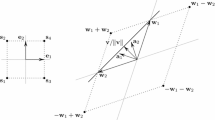Abstract
Anoracle for a convex setS ⊂ ℝn accepts as input any pointz in ℝn, and ifz ∈S, then it returns ‘yes’, while ifz ∉S, then it returns ‘no’ along with a separating hyperplane. We give a new algorithm that finds a feasible point inS in cases where an oracle is available. Our algorithm uses the analytic center of a polytope as test point, and successively modifies the polytope with the separating hyperplanes returned by the oracle. The key to establishing convergence is that hyperplanes judged to be ‘unimportant’ are pruned from the polytope. If a ball of radius 2−L is contained inS, andS is contained in a cube of side 2L+1, then we can show our algorithm converges after O(nL 2) iterations and performs a total of O(n 4 L 3+TnL 2) arithmetic operations, whereT is the number of arithmetic operations required for a call to the oracle. The bound is independent of the number of hyperplanes generated in the algorithm. An important application in which an oracle is available is minimizing a convex function overS.
Similar content being viewed by others
References
D.S. Atkinson and P.M. Vaidya, “A scaling technique for finding the weighted analytic center of a polytope,”Mathematical Programming 57 (1992) 163–192.
D.S. Atkinson and P.M. Vaidya, “Minimizing weighted self-concordant logarithmic barrier functions by scaling,” Preprint, Department of Mathematics, University of Illinois at Urbana-Champaign, Urbana, IL, 1992.
O. Bahn, J.L. Goffin, J.P. Vial and O. du Merle, “Implementation and behavior of an interior point cutting plane algorithm for convex programming: an application to geometric programming,” Working paper, Université de Genève, Genève, Switzerland, 1991.
D. Coppersmith and S. Winograd, “Matrix multiplication via arithmetic progressions,” in:Proceedings of the 19th Annual ACM Symposium on Theory of Computing (Association for Computing Machinery, New York, 1987) pp. 1–6.
D. den Hertog, “Interior point approach to linear, quadratic and convex programming: algorithms and complexity,” Ph.D. Thesis, Delft University of Technology, Delft, The Netherlands, 1992.
D. den Hertog, J. Kaliski, C. Roos and T. Terlaky, “A path-following cutting plane method for convex programming,” Working paper, Faculty of Mathematics and Informatics/Computer Science, Delft University of Technology, Delft, The Netherlands, 1992.
D. den Hertog, C. Roos and T. Terlaky, “A build-up variant of the path-following method for LP,” Report No. 91-47, Faculty of Mathematics and Informatics/Computer Science, Delft University of Technology, Delft, The Netherlands, 1991.
D. den Hertog, C. Roos and T. Terlaky, “Adding and deleting constraints in the path-following method for LP,” SHELL Report AMER.92.003, Royal/Shell-Laboratories, Amsterdam, The Netherlands, 1992.
R. Freund and K. Tan, “A method for the parametric center problem, with a strictly monotone polynomial-time algorithm for linear programming,”Mathematics of Operations Research 16 (1991) 775–801.
T. Gao, P.M. Vaidya and C.L. Liu, “A new performance driven placement algorithm,” in:Proceedings of the IEEE International Conference on Computer Aided Design 1991 (IEEE Computer Society Press, Los Alamitos, CA, 1991) pp. 44–47.
J.L. Goffin and J.P. Vial, “Cutting planes and column generation techniques with the projective algorithm,”Journal of Optimization Theory and Applications 65 (1990) 409–429.
M. Grötschel, L. Lovász and A. Schrijver,Geometric Algorithms and Combinatorial Optimization (Springer, Berlin, 1988).
F. Jarre, “The method of analytic centers for smooth convex programs,” Ph.D. Thesis, Institut für Angewandte Mathematik und Statistik, Universität Würzburg, Würzburg, Germany, 1989.
F. Jarre, “Interior-point methods for convex programming,” Technical Report SOL 90-16, Stanford University, Palo Alto, CA, 1990.
F. Jarre, “Practical aspects of an interior-point method for convex programming,” Technical Report SOL 91-9, Stanford University, Palo Alto, CA, 1991.
N. Karmarkar, “A new polynomial time algorithm for linear programming,”Combinatorica 4 (1984) 373–395.
L.G. Khachiyan, “A polynomial algorithm in linear programming,”Soviet Mathematics Doklady 20 (1979) 191–194.
L.G. Khachiyan and M.J. Todd, “On the complexity of approximating the maximal inscribed ellipsoid for a polytope,” Technical Report No. 893, School of Operations Research and Industrial Engineering, Cornell University, Ithaca, NY, 1990.
Y.E. Nesterov, “Complexity estimates of some cutting plane methods based on analytic barrier,” Technical Report, University of Geneva, Geneva, Switzerland, 1993.
Y.E. Nesterov and A.S. Nemirovsky,Interior-point Polynomial Algorithms in Convex Programming (SIAM, Philadelphia, PA, 1993).
J. Renegar, “A polynomial-time algorithm, based on Newton's method, for linear programming,”Mathematical Programming 40 (1988) 59–93.
S.S. Sapatnekar, V.B. Rao and P.M. Vaidya, “A convex optimization approach to transistor sizing for CMOS circuits,” in:Proceedings of the IEEE International Conference on Computer Aided Design 1991 (IEEE Computer Society Press, Los Alamitos, CA, 1991) pp. 482–485.
G. Sonnevend, “An analytic center for polyhedrons and new classes of global algorithms for linear (smooth, convex) programming,” Preprint, Department of Numerical Analysis, Institute of Mathematics, Eötvös University, Budapest, Hungary, 1989.
S.P. Tarasov, L.G. Khachiyan and I.I. Erlich, “The method of inscribed ellipsoids,”Soviet Mathematics Doklady 37 (1988) 226–230.
P. Vaidya, “A locally well-behaved potential function and a simple Newton-type method for finding the center of a polytope,” in: N. Megiddo, ed.,Progress in Mathematical Programming: Interior Point and Related Methods (Springer, Berlin, 1989) pp. 81–90.
P.M. Vaidya, “A new algorithm for minimizing convex functions over convex sets,” in:Proceedings of 30th Annual IEEE Symposium on Foundations of Computer Science (IEEE Computer Society Press, Los Alamitos, CA, 1989) pp. 338–343; also:Mathematical Programming, to appear.
P.M. Vaidya, “An algorithm for linear programming which requires O(((m+n)n 2 + (m+n)1.5 n)L) arithmetic operations,”Mathematical Programming 47 (1990) 175–201.
Y. Ye, “A potential reduction algorithm allowing column generation,”SIAM Journal on Optimization 2 (1992) 7–20.
Author information
Authors and Affiliations
Additional information
Supported by the National Science Foundation under Grant CCR-9057481PYI.
Supported by the National Science Foundation under Grants CCR-9057481 and CCR-9007195.
Rights and permissions
About this article
Cite this article
Atkinson, D.S., Vaidya, P.M. A cutting plane algorithm for convex programming that uses analytic centers. Mathematical Programming 69, 1–43 (1995). https://doi.org/10.1007/BF01585551
Received:
Revised:
Issue Date:
DOI: https://doi.org/10.1007/BF01585551




